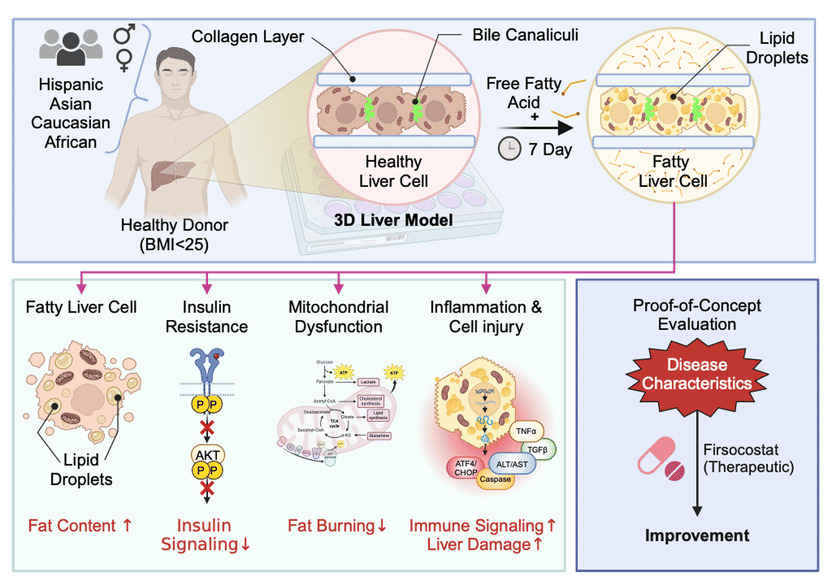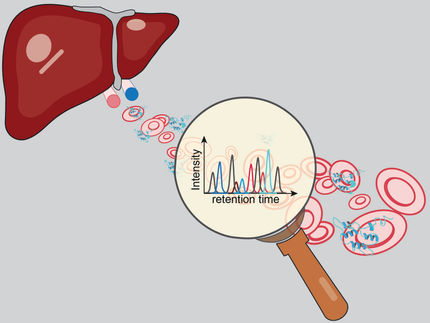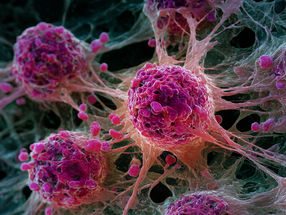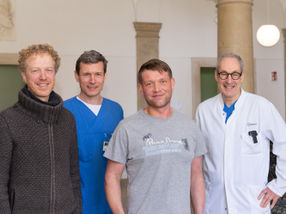A cellular model system for drug development in fatty liver disease
A 3D in vitro cell culture model as a basis for the development of new treatment strategies for one of the most common diseases in industrialized nations
Scientists from the Medical Faculty Mannheim, Heidelberg University have developed a model system that can be used to test the efficacy of drugs for fatty liver disease. It is a three-dimensional (3D) in vitro cell culture system based on primary human liver parenchymal cells (hepatocytes).

The model system: Healthy liver cells of different origin are cultured in a 3D collagen sandwich system and development towards fatty liver cells is induced using free fatty acids. The cells exhibit all the pathologies of a typical fatty liver disease.
Image created using BioRender, Kwon Y et al.
The model system can help to identify novel target molecules for the treatment of fatty liver disease. It can also be used to develop treatment strategies that take into account differences in sex and ethnicity among patients.
Liver diseases are one of the biggest health problems worldwide and one of the most common causes of death. The causes of liver disease are varied. They often have to do with metabolic disorders and are associated with obesity and diabetes. One in four people is affected by metabolic dysfunction-associated steatotic liver disease (MASLD).
The number of MASLD diseases is increasing worldwide without drugs being available for this indication. Therapies targeting different molecular signaling pathways are still being tested. Therefore, treatment strategies are largely focused on eliminating causes and risk factors that favor the development of fatty liver.
However, these measures, which affect lifestyle and diet, are associated with low patient compliance. There is therefore an urgent need for reliable and effective drugs to treat fatty liver disease associated with metabolic disorders.
The system developed by a team of researchers from the Department of Basic Principles of Metabolic Diseases at the European Center for Angioscience (ECAS), led by Professor Dr. Anja Zeigerer, differs from other in vitro cell culture models in that it uses primary human hepatocytes instead of immortalized human cell lines, which are often used in research. The cells isolated directly from the liver and cultured in a 3D collagen sandwich system have the advantage that they retain their bipolar morphology typical of liver cells and thus also their cell type-specific and metabolic (sugar and fat metabolism) functions.
The liver cells come from several healthy donors. A simple treatment with low concentrations of free fatty acids over a few days is sufficient to convert the primary cells into typical fatty liver cells with the characteristic pathologies. This makes such primary hepatocyte cultures an ideal in vitro system to study MASLD.
In fact, the model system has already provided a new insight: contrary to the scientific assumption that dietary fat and the new synthesis of fatty acids in the liver – in addition to free fats from the adipose tissue – contribute to MASLD development, this system shows that free fatty acids alone are sufficient to realistically simulate the disease in vitro.
At present, the platform is primarily a preclinical validation system that can be used to investigate the efficacy of drugs close to the human system. In future studies, the researchers in Mannheim will use the system to study fatty liver disease in more detail, for example by investigating the contribution of different nutrients to the disease pathogenesis.
Original publication
Yun Kwon, Pascal Gottmann, Surui Wang, Joel Tissink, Karsten Motzler, Revathi Sekar, Wiebke Albrecht, Cristina Cadenas, Jan G. Hengstler, Annette Schürmann, Anja Zeigerer; "Induction of steatosis in primary human hepatocytes recapitulates key pathophysiological aspects of metabolic dysfunction-associated steatotic liver disease"; Journal of Hepatology
Most read news
Original publication
Yun Kwon, Pascal Gottmann, Surui Wang, Joel Tissink, Karsten Motzler, Revathi Sekar, Wiebke Albrecht, Cristina Cadenas, Jan G. Hengstler, Annette Schürmann, Anja Zeigerer; "Induction of steatosis in primary human hepatocytes recapitulates key pathophysiological aspects of metabolic dysfunction-associated steatotic liver disease"; Journal of Hepatology
Topics
Organizations

Get the analytics and lab tech industry in your inbox
By submitting this form you agree that LUMITOS AG will send you the newsletter(s) selected above by email. Your data will not be passed on to third parties. Your data will be stored and processed in accordance with our data protection regulations. LUMITOS may contact you by email for the purpose of advertising or market and opinion surveys. You can revoke your consent at any time without giving reasons to LUMITOS AG, Ernst-Augustin-Str. 2, 12489 Berlin, Germany or by e-mail at revoke@lumitos.com with effect for the future. In addition, each email contains a link to unsubscribe from the corresponding newsletter.
























































